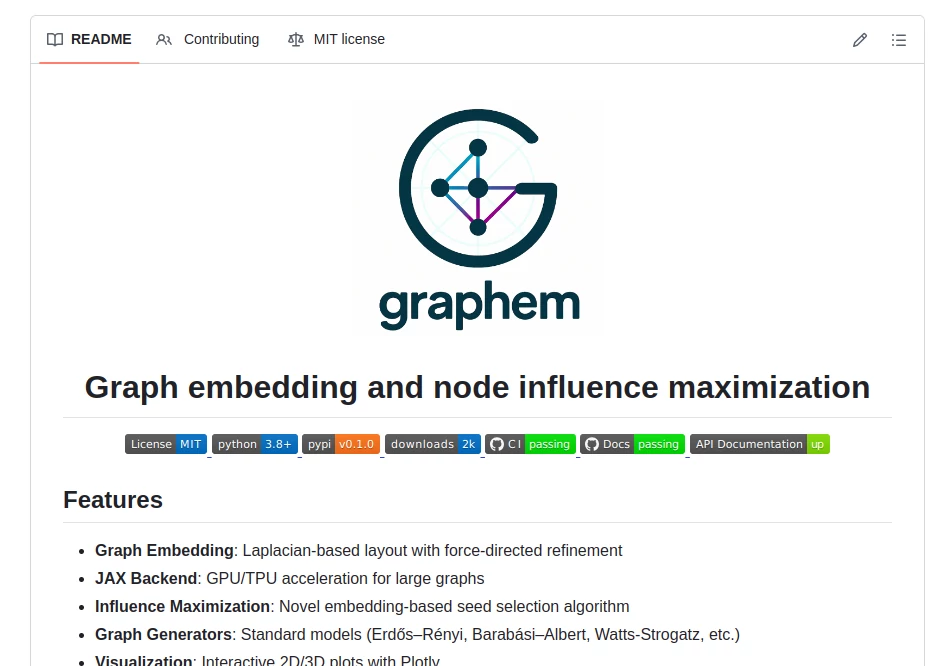GraphEm-JAX
Embed Graphs for Smarter Network Insights

What is GraphEm-JAX?
Graphem steps in as a handy toolkit for folks wrestling with network data, letting them squeeze out patterns and key players without the usual headaches. This open-source gem shines by mapping out connections in ways that reveal hidden strengths, all while keeping things zippy even for hefty setups. Developers and analysts who've tinkered with it often light up about how it turns tangled webs into clear views, sparking ideas that lead to sharper decisions in everything from social circles to supply chains.
Introduction
Graphem kicked off when a sharp mind spotted the gap between clunky old-school graph tools and the need for quick, insightful layouts in today's data deluge. It started as a side project blending math smarts with practical code, and soon enough, it caught the eye of researchers juggling big datasets who craved something that just worked without endless tweaks. Over the months, feedback from early users polished it into a solid go-to, with folks sharing stories of late-night breakthroughs where a fresh embedding flipped their whole approach. What grabs hold is its knack for blending theory with hands-on ease, making complex connections feel approachable rather than overwhelming, and it's steadily carving out a spot among the go-to kits for network explorers.
Key Features
User Interface
Things kick off in a familiar code environment, where you fire up a simple class and watch it hum along with your inputs. Once the layout's ready, interactive plots spring to life, letting you zoom, spin, and poke around nodes like flipping through a digital sketchbook. It's all wrapped in notebook-friendly calls that keep the flow smooth, so even if you're knee-deep in a Jupyter session, the visuals pop without pulling you out of your groove.
Accuracy & Performance
It nails the finer points of node placements by leaning on proven math tricks that hug the graph's true shape, often matching hand-tuned results while dodging common distortions. On beefier machines, it zips through thousands of points in a flash, thanks to smart backends that spread the load, leaving you with crisp outputs that hold up under close scrutiny without the drag of older methods.
Capabilities
From whipping up random networks to loading real-world bunches like social feeds or citation webs, it covers the bases for building and probing structures. You can zero in on power players with clever picks or benchmark how well the views line up against classic metrics, all in one tidy package that stretches from basic sketches to deep dives into spreads and influences.
Security & Privacy
As an open book of code, it keeps your data local and under your thumb, with no sneaky sends or hidden hooks—everything runs on your turf. The setup sticks to clean, standard practices that let you peek under the hood, so you're always in the know about what's crunching your numbers without any surprise shares.
Use Cases
Social network sleuths map out cliques and bridges to spot rising voices in online buzz. Supply chain watchers trace bottlenecks by embedding flows, tweaking paths to smooth out snarls before they snag. Researchers in citations use it to highlight game-changers, weaving embeds into papers that wow at conferences. Even game designers sprinkle it in for balanced worlds, ensuring connections feel fair and fun from the get-go.
Pros and Cons
Pros:
- Blends heavy math with light code for quick wins on big data.
- Interactive views make spotting patterns a breeze.
- Built-in generators save time hunting test beds.
- Open setup invites tweaks to fit your exact puzzle.
Cons:
- Needs a bit of code comfort to unlock the full swing.
- Heavy graphs might crave extra hardware for peak speed.
- No out-of-box dashboards—it's more builder than browser.
Pricing Plans
True to its open roots, Graphem hands over the whole kit for zero upfront, with pip pulls that slot right into your workflow. Folks chasing extras might dip into backend tweaks for hardware boosts, but the core stays free as air, letting you scale from hobby hacks to pro probes without a bill sneaking up.
How to Use Graphem
Start by grabbing it through your package manager, then spin up a graph from a quick generator or your own edges. Feed it to the main engine with your specs, run the layout loop till it settles, and call up the display to wander the results. From there, layer on picks for standouts or run checks against benchmarks, tweaking params as the insights roll in.
Comparison with Similar Tools
Where some kits stick to basic spreads, Graphem layers in smart approximations that cut corners without skimping on truth, though those might edge out for super-simple snaps. Against full-blown suites, it keeps the footprint light, dodging bloat for coders who prize speed over screens. It carves its lane for embed fans wanting math muscle without the markup, blending the best of both without the worst.
Conclusion
Graphem wraps up the hunt for network know-how by handing you tools that illuminate without the glare, turning raw links into revelations that stick. It empowers tinkerers to chase curiosities deeper, yielding views that inform and inspire long after the code quiets. As connections keep knotting tighter, this little engine hums on, proving that a clear map beats a mile of guesswork every time.
Frequently Asked Questions (FAQ)
What's the quickest way to see it in action?
Fire up the sample notebook online—it's got ready runs that showcase the magic in minutes.
Can it handle my massive dataset?
With the right setup, it scales to thousands of nodes, leaning on accelerators for the heavy lifts.
How do I tweak for my graph type?
Pass in your edges and dims, then play with iteration counts to dial in the fit.
Is there support for real-world loads?
Built-in pulls for common packs make importing a snap, ready for your spins.
What if I spot a glitch?
Hop to the issues page— the crew keeps an eye out for fixes and features.
AI Data Mining , AI Research Tool , AI Developer Tools , Other , Github Repos .
These classifications represent its core capabilities and areas of application. For related tools, explore the linked categories above.
GraphEm-JAX details
This tool is no longer available; find alternatives on Alternative to GraphEm-JAX.
Pricing
- Free
Apps
- Web Tools
















